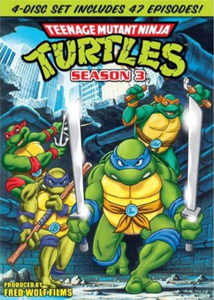In “Teenage Mutant Ninja Turtles” Season 3 episodes 9-21 (1989), we can see the writers straining against the quick production schedule to give us more imaginative episodes. They don’t limit themselves to movie homages/parodies, and instead expand the Turtle-verse itself in wild ways. This batch has no elite episodes, but it does have several fun ones.
Unfortunately, the ambition is often more impressive than the execution; sometimes the one-liners connect, but – with notable exceptions – the animation suffers in this batch. Even the best efforts are undone by a flaw such as a main voice actor having the day off. Two installments (“Cowabunga Shredhead” and “Green with Jealousy”) are hurt by Pat Fraley (Krang) being absent, replaced by Michaelangelo actor Townsend Coleman.
It’s incredibly distracting when Thom Pinto stands in for Rob Paulsen as Raph in “Ninja Sword of Nowhere.” Greg Berg is an appropriately geeky Donatello backup in “20,000 Leaks Under the City” and “Four Musketurtles,” but I prefer Barry Gordon’s Woody Allen stylings.

“Teenage Mutant Ninja Turtles” Season 3, episodes 9-21 (1989)
Syndicated
Episodes: “Enter the Rat King” (9), “Turtles at the Earth’s Core” (10), “April Fool” (11), “Attack of Big MACC” (12), “The Ninja Sword of Nowhere” (13), “20,000 Leaks Under the City” (14), “Take Me to Your Leader” (15), “Four Musketurtles” (16), “Turtles, Turtles, Everywhere” (17), “Cowabunga Shredhead” (18), “Invasion of the Turtle Snatchers” (19), “Camera Bugged” (20), “Green with Jealousy” (21)
Producer: Fred Wolf
Writers: Buzz Dixon (9), Michael Reaves (10, 11), Brynne Stephens (11), Francis Moss (12, 19), Michael Edens and Mark Edens (13, 20), Bob Schooley and Mark McCorkle (14), David Wise (15), Doug Molitor (16), David Carren and J. Larry Carroll (17), Duane Capizzi and Steve Roberts (18), Reed Shelly and Bruce Shelly (21)
The Rat King enters the rat race
Although this batch mostly relies on the familiar Shredder and Krang schemes wherein they use weird science to try to repower the Technodrome or take over the world, we do finally get the first non-S&K episode, “Enter the Rat King” (episode 9, written by Buzz Dixon) – the 27th overall.
In bringing an early Mirage villain (who debuted in 1988’s “Tales” Issue 4) to the show, the animators try to be evocative with rainfall and the expansion of the sewer populace. The title character lives in an abandoned subway station, though not one as impressive as the Turtles’ from “TMNT II: The Secret of the Ooze.”

I wanted more from the Rat King vocal performance (a misfire by Coleman, although it must be said that he’s iconic as Mikey), and he is essentially defeated by Irma stomping on his foot. But he does serve as a real threat to Splinter (his philosophical rival in the comics), whom he can hypnotize with a magic flute.
Characters being mind-controlled, body-swapped, possessed or suffering from amnesia is a theme of this batch, as if the broad concept was brought up in the writers’ room and everyone went off to do their own version.
More homages to classics
Before I get to the creative episodes, I’ll first run down the standard classic homages. “Turtles at the Earth’s Core” (10, Michael Reaves) riffs on Jules Verne’s “Journey to the Center of the Earth.” The Turtles’ relationship with Dippy the Diplodocus – with Donnie riding on his head and the others on his back – is cute, and we see a colorful new background environment.
“20,000 Leaks Under the City” (14, Bob Schooley and Mark McCorkle) would presumably also be a Verne homage, but that extends only as far as the title. Still, I like it as a fast-paced romp filled with puns about water, the ocean and sea creatures. Its understanding of volumetrics is even dumber than when a skyscraper floods in “Enter the Shredder” (Season 1) – here, Krang aims to drain the ocean – but every “TMNT” episode is dumb when put up against the rules of hard science.
An episode that’s goofy but energetic shouldn’t be sneezed at, because we can see when things don’t click, such as in the (appropriately) redundant “Turtles, Turtles, Everywhere” (17, David Carren and J. Larry Carroll). When the premise depends on Shredder lazily ordering super-smart computer DUMP 1000 to grab “the turtles” (rather than the “Teenage Mutant Ninja Turtles”), we know the writers are being lazy.
“April Fool” (11, Reaves and Brynne Stephens) is notable for featuring April in a ball gown rather than her trademark yellow jumpsuit. It’s clunkily written for a Reaves joint as it riffs on princess-switch and class-difference stories such as “Cinderella.”
“Four Musketurtles” (16, Doug Molitor) does the Olde English idea much better, as an amnesiac Leonardo (an all-in Cam Clarke) believes he is D’Artagnan, his brothers are the Three Musketeers and Splinter is his servant (to a viewer’s amusement but not the ninja master’s).
Nothing to be jealous about
I should like “Green with Jealousy” (21, Reed Shelly and Bruce Shelly), the requisite “love potion” story, more than I do. Clarke again pours himself into a performance, this time as a Rocksteady smitten with April. Meanwhile, three of the Turtles are obsessed with Irma. Maybe because the “Buffy” episode “Bewitched, Bothered and Bewildered” takes the identical concept and makes it much funnier and deeper, I find this entry surprisingly flat.
“Attack of Big MACC” (12, Francis Moss) plays on “Short Circuit” and “The Terminator” but can’t decide on its message. Time-portal-hopping robot MACC chides 1989 Earth for being easily recognizable by its violence, yet he himself is a war robot! This is the weakest episode among these 13.
The weakest episode that should be a good episode is the unusually character-driven “Take Me to Your Leader” (15, series creator David Wise). Leo suffers a crisis of confidence and walks out on his brothers! So we get to see the other three try to be leaders, and the reasons why they aren’t as good at this skill as Leo.
Although S&K’s scheme of draining the sun (!) would seem to be nutty enough to be fun, there’s a blandness to the animation and action as NYC gets buried in snow. Luckily, the superior Leo episode “Musketurtles” is next in the lineup, washing this well-meaning misfire away.
Signs of creativity
Now on to the standout half-hours. “The Ninja Sword of Nowhere” (13, Michael Edens and Mark Edens) features Shredder’s titular blade that can slice a gateway to other dimensions (in evocatively animated fashion), and the scary notion of Splinter being trapped in a void called Limbo. Every now and then, an episode is animated quite well. A standout throwaway moment comes when Mikey lands from a high fall tucked into his shell; then he pops out his limbs and head.
“Invasion of the Turtle Snatchers” (19, Francis Moss) is a nod to “Invasion of the Body Snatchers” in title only. The abduction premise turns creative when Rocksteady and Donatello must team up to deal with an alternate realm that turns out to be a “Star Trek” Holodeck of sorts. The alien family members are named Klaatu, Barada and Nikto; as a kid I thought this was a “Return of the Jedi” deep cut before I learned “Jedi” itself was paying homage to “The Day the Earth Stood Still.”
“Camera Bugged” (20, Edens and Edens) takes the alternate-reality idea further as everyone ends up inside a video camera thanks to a reckless tourist alien. The ensuing romp is a mash-up of “The Langoliers” and the “Buffy” episode “Restless,” as the world is both empty and filled with its own laws of physics. If “TMNT” didn’t have a reputation of making up its own pseudo-science in silly ways, “Camera Bugged” might be respected as a sci-fi mind-bender.
Hungering for cowabunga
The major takeaway from this batch is the voice acting – for better or worse. Fan-favorite episode “Cowabunga Shredhead” (18, Duane Capizzi and Steve Roberts) features both. Krang is voiced by second-stringer Coleman (Michaelangelo), only reminding us how good Fraley is.
On the other hand, James Avery has a blast doing an over-the-top surfer dude voice as Shredder thinks he is Michaelangelo, and thus he “hunger(s) for cowabunga.” I think the animation assignments are as random as the voice actors’ days off, and here we get the studio that does cartoony gumby-like work (I think they were first featured in the poorly animated “Enter: The Fly” in Season 2).
While this means all scenes with movement – running, let alone fights – look horrible, the style plays OK for pure comedy episodes. Luckily, this is one.
Granting the several smile-worthy moments among this baker’s dozen, it’s still “Enter the Rat King” And A Bunch Of Other Episodes. Even on a rewatch as an adult, I want to see the action figures in action. That will finally happen in a big way in the next batch.

